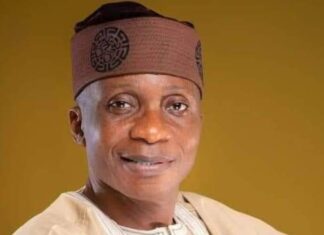The mystery gunman and other myths from the East
On 15 October, 1965, as political uncertainty and violence raged in Western Nigeria, Ladoke Akintola, the regional Premier, was due to deliver a primetime radio broadcast to his people at 19:00. Some minutes before the appointed hour, an armed, unmasked and bearded young man appeared in the studio and required Akinwande Oshin, head of the newsroom at the Western Nigeria Broadcasting Corporation (WNBC), to substitute the recorded broadcast of the Premier with a tape provided by the gunman. At the appointed hour, the entire region – including the Premier – listened as the voice from the gunman’s tape exhorted the Premier to spare the region further turmoil and go.
His mission accomplished, the gunman promptly vanished into the night, leaving Mr. Oshin and his crew in the newsroom with some questions to answer. The incident would later result in criminal proceedings against a suspect, later identified as Wole Soyinka, at the time a lecturer at the University of Ibadan. In his defence, Mr. Soyinka set up an alibi, claiming that he was in Enugu in the then Eastern Region of Nigeria at the time of the incident. In his testimony, Soyinka’s Head of Department at the university, one Professor Axworthy, said that they had both attended a departmental meeting in Ibadan less than two hours before the incident but the Wole Soyinka with whom he attended the meeting, according to the professor, was clean shaven.
The mystery of how a clean shaven man could grow a bushy beard in less than two hours was too much for the trial Magistrate, who felt obliged to acquit the suspect. Kayode Eso, the trial Magistrate, who would go on to a storied judicial career within and beyond Nigeria, immortalized this story in his book fittingly titled “The Mystery Gunman.”
The mystery gunman is a figure of considerable antiquity in the history of crime and impunity in Nigeria and of myths about both. A mere 11 and a half years after that incident in Ibadan, soldiers brutally attacked Wole Soyinka’s aunt, Funmilayo Ransome-Kuti, in the Kalakuta Republic base of her famous son and Afrobeat musician, Fela Anikulapo-Kuti. A judicial commission of inquiry established to identify the perpetrators and recommend suitable measures of accountability, concluded that the attack was the handiwork of the “unknown soldier”. With the act attributed to so ghostly a figure, suggestions of accountability became evidently illusory.
READ ALSO: Olubadan strips Wale Oladoja of Mogaji title
In south-east Nigeria, where a metastasis of murderous violence is widely perceived to have held sway for the better part of the last five years, responsibility for this state of affairs is laid at the feet of the Unknown Gunman. Tired of having to repeat the name with the frequency with which murders, abductions, and violence occur in and around the region, many people have taken to abbreviating the nomenclature to “UGM”. With no memory of what transpired before, the UGM is mostly seen as a novelty in the contemporary ecosystem of violence in Nigeria generally and in the south-east more particularly. In reality, he is neither new nor indeed unknown.
Nearly 10 years ago, when he disappeared on his way to his community in Nanka, Orumba North Local Government Area (LGA) of Anambra State in May 2014, it was reported that former Anambra State Commissioner for Science and Technology, Chike Okoli, had been “abducted by unknown gunmen.” But one month later, the Anambra State directorate of the State Security Service (SSS) arrested a 10-man kidnap-for-ransom gang, whom they alleged was responsible for the kidnap and disappearance of Mr. Okoli. It was led by one Kingsley Chukwuemeka Eze, a local politician from Enugu State.
The abduction and disappearance of Igwe Oliver Nnaji, traditional ruler of Ogwu Aniocha in Ogbaru LGA in November 2021, was similarly reported at first as the handiwork of the “UGM”. However, at the beginning of January, 2023, a raid by a Special Forces assault team on the Ochan Forest in the community reportedly led to the killing of ten members of a crime gang led by one Victor Ibenegbu (alias “Network”), who claimed that “his group was behind the serial killings and arsons in the community”, including the abduction of the traditional ruler.
With the police decimated and devoid of confidence, the investigation of the violence does not receive the kind of assets or commitment it deserves. Most victims and witnesses are not unaware of the authors of the violence in their neighbourhoods. But they are equally mostly unwilling to go on record for fear of suffering reprisals. The use of “unknown gunmen” to describe the perpetrators is a misnomer. In most cases, they are known but the expression, UGM, describes a tyranny of despondency in the face of widely held perceptions of state incapacity or impunity for these atrocities.
Over nearly 20 months of leading the Truth, Justice, and Reconciliation Commission (TJPC) into the violence in the south-east of Nigeria, it has become evident to me that the UGM is one of the narrative myths and constraints in the crisis of violence and insecurity in the region. It is by no means the only one. You also have the reality of a population forced by the violence into a habit of fear of candour on the subject; an absence of a public or bureaucratic infrastructure of both memory and records of victimization; a narrative space at both national and state levels unwilling to look beyond separatism as the explanation for the violence; and a policy space attuned only to expeditionary and kinetic responses.
These myths have sustained the mis-begotten idea of a unified filed theory for the violence in south-east Nigeria. Anyone interested in addressing this situation must be prepared to look beyond the myths. For whoever is prepared to do so, the pursuit could prove both revealing and richly rewarding.
In Anambra State, for instance, the political economy of land is central to understanding the crisis of violence. It is both property and identity and the supply of land in the state is shrinking under the combined assault of fragilities from both nature and of intense land use. Revenues from land, are the focus of an intensity of competing interests. In this competition, cults and organized crime gangs are recruited. These cults and gangs bring with them guns, drugs, and even transactional idolatory. Over time, they also develop a seasonal and entrepreneurial orientation to violence, selling it to whoever is interested, from artisanal rustlers of solid minerals or hydro-carbons to private persons using it to settle scores; from community factions disputing over the stool of the Igwe or positions in the Town Union to politicians seeking offices in the state.
From the political economy of land, other shorter term factors radiate out, including the mismanagement of transhumant pastoralism; (mis-)appropriation of a narrative vacuum created by official government policy concerning memory from Nigeria’s past; intra-state and inter-community boundary crises; transactional idolatory; the franchising of agitation by criminal cults and gangs; as well as the deployment of violence for artisanal extractive and mining activities and for electoral politics.
For both politicians and security agencies, the focus on mobilizing kinetic responses preoccupies itself overly with the symptoms at the expense of addressing the real causes. The implicit idea that the country or the region can shoot its way out of the violence and its causes and consequences is in one word, delusional. Tactical options must always be on the table but, for durable solutions, the country and the region must dispense with the myths and govern their way out of the disease. That is the only way to make the symptoms finally disappear.
- A lawyer and a teacher, Odinkalu can be reached at chidi.odinkalu@tufts.edu















